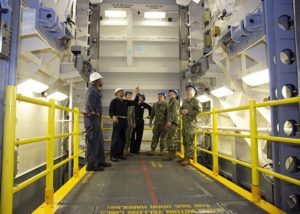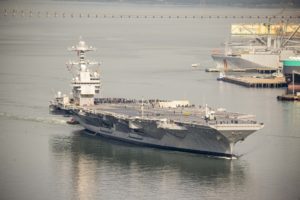The Navy’s top acquisition official recently said the first lower weapons elevator on the USS Gerald R. Ford (CVN-78) has finished testing and will soon be turned over to the crew while the full set of 11 elevators will be ready by next summer.
“You’ll see an announcement coming up shortly on the first lower elevator. It’s cleared all of its testing and you’ll see an announcement very soon that it’s been certified and turned over to the crew,” Assistant Secretary of the Navy for Research, Development and Acquisition James Geurts told reporters during a press call April 16.

He also reiterated his goal is to have all the of the elevators “up and running prior to our full shock trials, planned for next summer. So that’s where we are focused.”
In January, Capt. Ron Rutan, CVN-78-class program manager, said the AWE’s would be completed before May 2021 (Defense Daily, Jan. 17).
The Ford is currently operating under an 18-month Post-Delivery Test and Trials (PDT&T) period, which began last fall. Last October, Geurts confirmed the first four of the long-delayed Advanced Weapons Elevators (AWEs) were turned over to the crew while seven more were still completing installation and certification (Defense Daily, Oct. 29, 2019).
The fifth elevator that has finished testing is the important lower elevator that reaches from the flight deck to the magazines low within the ship. The seven remaining elevators not yet turned over to the crew include these lower elevators.
The Ford-class carriers and their AWEs are both built by prime contractor Huntington Ingalls Industries [HII].
Geurts said the Navy-HII team is slightly ahead of schedule on the AWEs, but their “main focus is getting these first two lower elevators turned over because that will allow full access from the magazine all the way to the flight deck.”
“And why that’s important is so the ship can train and start exercising kind of the full cycle of cyclic operations. Follow-on elevators just add capacity and so one gives them the capability to access, then the second is to have redundancy and capacity. And so we’re focused on giving them access first to the forward and aft magazines,” Geurts continued.
The acquisition chief underscored while this is happening the Ford is deployed for about 50 percent of its time in this PDT&T period and is “very proud” of the creativity and work of the shipbuilders continuing AWE work during those at-sea periods.
In the wake of long delays in the Ford’s deployment, partly due to the delayed elevators, Geurts noted the Navy and HII team have learned that there needs to be a sort of specific elevator trade to build, install, and test the new AWE technology.

“So what the shipbuilder has done is create essentially an elevator trade. They have a separate kind of schoolhouse and so we’re essentially using Ford to build the teams that will then continue and flow all the way through all the follow-on [CVN-79 to 81 carriers].”
Geurts noted HII is conducting work on the next carriers, particularly the future USS John F. Kennedy (CVN-79), but the team is staging work so they can take lessons from the CVN-79 construction to move even faster on the follow-on ships.
He warned that due to the learning curves HII signed up to for the next ships, “they’re also going to have to improve their efficiency in getting the work done. So we’re proving how to get the work down, we’re getting the procedures down, we’re getting the training down and the techniques down and then they’re going to have to continue on that learning curve through the next three carriers we have on contract.”
Geurts also provided updates on the Ford’s PDT&T status. He noted it recently completed its longest at-sea period at about 32 days. While underway, CVN-78 conducted 1,352 aircraft launches and recoveries, known as ‘cats and traps.’
He said this was a 200 percent increase over when it first went out to sea and specified while at sea the Ford qualified 97 pilots ranging from Carrier Air Wing 8, Strike Fighter Squadron 106, E-2 Hawkeye pilots, students, and instructors from Naval Air Training Command.
“So Ford is out, it is generating readiness for the fleet and it is doing some great work for us out there,” Geurts said.